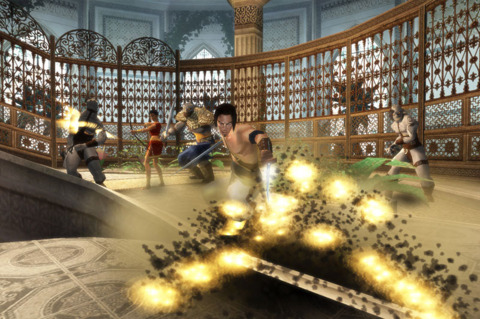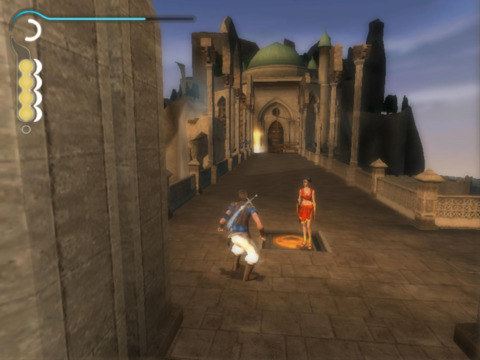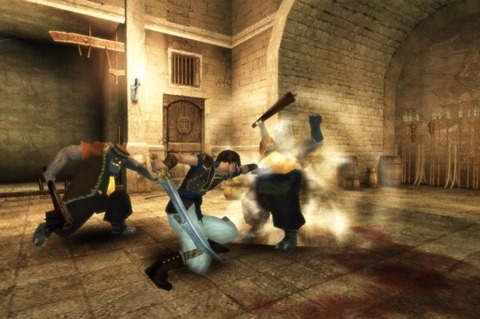Thoughts on Prince of Persia: The Sands of Time
By TheYouthfuls 16 Comments
This article contains spoilers for the entire game. Although it isn't a story-heavy game, be warned that the last few paragraphs discuss the ending.
A few weeks ago, I revisited a series that I hadn't touched in about 6 years: Prince of Persia. This decision filled me with both excitement and trepidation, the former due to the massive amounts of nostalgia that I was sure to experience, and the latter a fear that the game wouldn't hold up to my childhood memories.
So how was it?
The Sands of Time starts with an introductory CG cutscene, but despite it looking better than the gameplay, the animations are actually far more unnatural. The resolution is also expectedly awful, with plenty of compression artifacting that makes it an overall unpleasant viewing experience. However, going into gameplay we find a well animated Prince, with wall running and jumping, the gameplay of which still holds up to this day. All of the platforming feels immediately fluid, proving why it was such a well-received game on its initial release.
Something that is extremely odd by today’s standards is the camera; instead of the now traditional method of controlling the angle, left and right on the analogue stick rotates the camera around, but up and down merely zoom in and out. This means you aren’t able to easily look above you without going into first-person. At least it’s a minor problem, jarring only due to how un-optimal it now feels. The camera in Sands of Time is one of the core elements of its presentation because of how cinematic it tries to be, for better or worse. Some camera shots look fantastic, showcased by a few of the platforming and wall-running segments, where the camera zooms out to show both the Prince’s starting location and where he’ll eventually end up. Other times the camera has a very sudden change that can mess with the direction you happen to be walking in. It may also clip through some of the architecture or not pan nearly as smoothly as it should. No matter what happens with the camera though, you can be sure that you’ll hear the ‘SWOOSH’ sound effect that Ubisoft seemed to be so fond of during development. Making the presentation seem forced, as if they were trying to show off the power of the PS2 as much as possible (3 years into its lifecycle). Camera angles throughout the platforming segments are dictated by the game, and this serves to make Prince of Persia feel like a true, 3D evolution of the cinematic platformer it spawned from.

Whilst running, jumping, swinging etc. you feel very involved, far more so than games such as the Assassin’s Creed series, which appears to be a spiritual successor to Prince of Persia, despite Ubisoft’s attempts at bringing the franchise back after the first AssCreed game was released. The control of your movement makes these parts resemble actual 3D platforming, as opposed to parkour. The animations are fluid so that if you are able to string movements together (not hanging on a single ledge for too long), gameplay starts to look closer to parkour, something naturally rewarding for myself.
Moving on from platforming to the other significant gameplay of the Prince of Persia series: combat. This is where things start to fall apart for The Sands of Time; unfortunately the combat gets repetitive and therefore boring quite quickly. Soon it became an absolute chore that I was eventually determined to avoid at all costs. Luckily, I was able to accomplish this a few times by running past all the enemies to some of the few places which weren't sectioned off, allowing me to progress.
But why does engaging in combat become such a fear? A lack of combos certainly lends to the monotony; you can jump from one enemy to the other and string the same set of attacks together, but there isn’t a list of combos available to you because there really aren't any in the game at all. Instead of performing combos, you can do a variety of one-off attacks such as jumping over enemies, slashing their backs and jumping off of a wall to get an advantage as well. While these are fun to do for the first hour or so--and it’s commendable that the developers were so dedicated to the agile nature of the Prince that they incorporated such acrobatic moves into the combat--it’s not enough to prevent it from becoming a grind. This reinforced my annoyance with the combat leading up towards the end of the game, at which point you obtain a new sword that is able to kill enemies in one or two hits.
I was far happier about this than anyone should have been. The joy didn't just come from the feeling of immense power, but from the realisation that combat would now be over much sooner. Anything like this in a game, when you’re happy because you don’t have to do something that was annoying you previously, reflects poorly on its design.
Combat in Sands of Time may be boring, but definitely not devoid of challenge. You’ll likely have to use the dagger of time to rewind a great deal, especially as the game progresses and enemies become more challenging. Unfortunately, there is also a disappointing lack of variety in the enemies, whose frequency of new designs dwindles as time goes on. Yet, you can still see a decent amount of enemies when you look at the game as a whole. Individual fights tend to only throw two or three types at you at once, with these sections being prolonged by attackers that are only replaced by duplicates, making it seem as though you fought the exact same fight about five times in a row just to pad out the game.

While all this appears to be outdated, it comes down to generally poor design that holds The Sands of Time back, rather than technical limitations. What doesn't feel too outdated are the graphics; surprisingly the overall design of the environments still looks fairly good. I can’t speak for the console versions, but on PC with a modded patch allowing 1080p, everything was smooth, with a decent amount of detail and no noticeable aliasing. I was pleasantly surprised that I wasn't put off by the graphics. I'm sure sticking, for the most part, to very enclosed areas and symmetrical designs in temples likely aids the graphics in both their appeal and how much detail is able to be put in. As long as you play Sands of Time on PC--or through the HD collection on PS3--you’re sure to avoid being put off by the way it looks.
Going back to my childhood, I recall becoming confused at the many puzzles in The Sands of Time, even after playing my first Prince of Persia game: The Two Thrones. However, during my revisit I had little trouble with puzzles, of which there are far less than I remember. The majority of them involve turning levers until objects move or rotate into place, with that place being obvious because of either a symbol or the clear indication that you’ll be able to use what you've just altered to progress. I was only completely stumped during the final mirror puzzle because of a confusion of where the light was meant to be directed towards. Aside from this, all other previous struggles appeared to have vanished, with the game offering little challenge outside of the combat.
Even with this lack of challenge, Prince of Persia still provides entertainment through acrobatic sections that give peaceful breaks in between fighting. These are especially entertaining when among hazards such as saw blades, wall scissors and various other ridiculously implausible contraptions. The traps don’t fit in with the architecture in any logical way like modern games might have them; to even begin to think about someone designing these places in a realistic way is hilarious (“To prove their worth, guests of the palace should step on this pressure plate to open the door and then make their way through these deadly spikes and saws before the exit inevitably shuts!”). It’s gloriously video game-y and lends to the sense of nostalgia received when experiencing the series nowadays, calling back to a time when designers were more focused on creating interesting levels first and not realistic environments.

Dialogue between the Prince and Farah also adds to the enjoyability of Sands of Time, with most of the humour coming from how the Prince reacts to Farah’s comments. His remarks are pompous and ludicrous, even more so when he begins to see her as a prize to be won easily with his charm, despite lacking any semblance of such in his personality. Furthermore, this odd chemistry becomes less believable when their relationship suddenly develops romance. Farah could have avoided falling into a love interest, but she doesn't, and as such we are put through a more generic tale, even given the fact that Farah is actually useful for stunning enemies and isn't a typical damsel in distress at all times. Story-wise, Sands of Time does just enough to keep me engaged. While the Prince may be immature, he grows to have more integrity and honour through the journey: perhaps not the most complicated character progression, but satisfactory nonetheless.
Antithetically, the showdown with the vizier is one of the most mundane and anti-climactic final bosses I've ever experienced. It involves the moustache-twirling villain projecting a magical clone for you to fight. There might be a specific strategy to defeat this clone that doesn't involved leaping over him, slashing his back, and then repeating these two steps over and over until he’s dead, but I wasn't able to find it. After dispatching the clone, you attack the vizier himself and see how pathetic he is without the arbitrary barrier of protection he previously had. It makes sense in terms of the plot, but to have a final boss be constrained within a bedroom and subjected to such a pitiful pattern is disappointing to say the least.
In the end, the Prince has sadly undone the entire adventure using the hourglass, meaning his relationship with Farah is all but gone. I may have not gone into much detail about the time rewinding the series is known for, but all you need to know is this: it’s awesome. The mechanic is still a creative way to undo mistakes (keeping up the pacing of the game), slow down time for puzzles or combat, and give you a sense of power without being imbalanced. It isn't fully explored in this iteration, but continues to be expanded in interesting ways further on in the series. However, it is also detrimental to the story by enhancing plot holes in many scenes in which the Prince could have rewound time to undo a mistake. I found myself yelling at him multiple times, specifically when he falls down to a prison area; he could have undone the fall as I have during the gameplay so many times. Even with these issues, you can find enjoyment among the story, primarily for the characters, who I wish had the amount of dialogue we see in modern games such as the Uncharted franchise.
Although Prince of Persia: The Sands of Time might not retain ‘classic’ status in my eyes, it serves as fantastic launch for the series, remaining as one of the best to this day.
- Ben Lucas (@TheYouthfuls)
(Thanks to Ben Ballingall and 'Louie' for helping with proofreading!)
